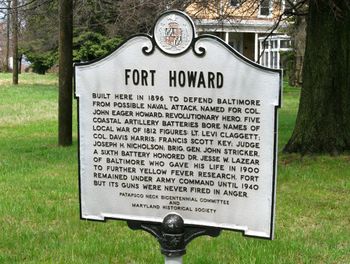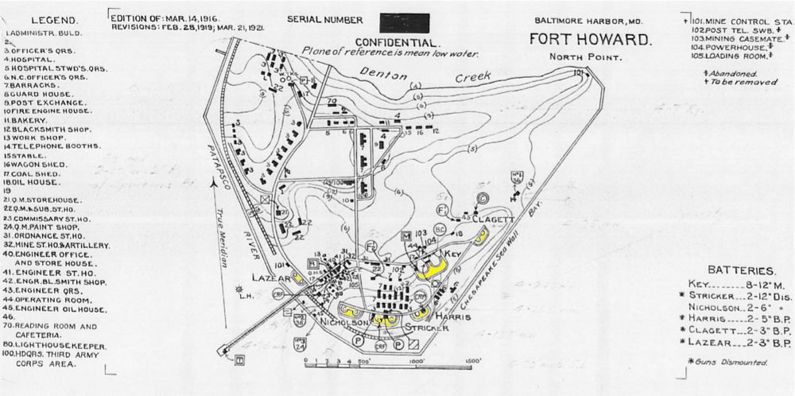Fort Howard (1)
|
Fort Howard (1) (1896-1940) - An Endicott Period Coastal Fort first established as North Point in 1896 and first garrisoned on 6 Jun 1899 by Battery E, 4th U.S. Artillery. Named 4 Apr 1900 after Col. John Eager Howard, a distinguished soldier of the Maryland Continental Line during the Revolutionary War. Became the headquarters for the Harbor Defense of Baltimore including Fort Smallwood, Fort Armistead (1), and Fort Carroll (1). Turned over to the Veterans Administration Aug 1940.
Endicott Period (1890-1910)Part of the Harbor Defense of Baltimore. The first acquisition of property for the Fort came as the result of an 1896 condemnation suit against the Canton, Sparrows Point and North Point Railroad "for the purpose of erecting fortifications for the defense of the City of Baltimore".
In June of 1899 Battery E, 4th U.S. Artillery, arrived to garrison the post. Additional support structures were built but construction of permanent Fort facilities did not begin until 1900-1901. Three additional tracts of land were obtained in late 1899 to complete the land acquisition for the fort. The Secretary of War, Elihu Root, named the post Fort Howard on 4 Apr 1900 and declared the assembled tracts of land to be a single military reservation on 18 Apr 1900 with General order No. 51. The last of the gun batteries were completed in 1901 and attention turned to building out the permanent infrastructure of the post. Major construction projects were completed in 1901 including two 100 man barracks, six junior officer quarters, quarters for four NCOs, a post hospital with stewards quarters, an administration building and a guardhouse that could accommodate 15 prisoners. On 11 Feb 1902 all six of the coastal gun batteries received their official names. Later in 1902, two additional officers quarters were completed, one for a captain and one for a field grade officer. In 1903, 1904 and 1905 additional NCO quarters were added. In 1905 a double set of junior officers quarters were completed and in 1906 another field grade officers quarters was added along with a post exchange and gym. In 1910 an additional 109 man barracks and quarters for four NCOs were completed. 1911 added a fire station and a quad set of junior officer quarters. By 1912 the post was well built out and contained most of the permanent facilities that one could expect from post this size. On 1 Mar 1912 the post proper was electrified and electricity was available for the first time all over the post including officer, NCO and enlisted quarters.
World War I (1917-1918)World War I began in Europe in August 1914 but it was not until late 1916 that it became clear the U.S. would be involved. On 17 Jul 1916 Fort Howard was declared a "recruit rendezvous" and a determined effort was started to build out enough temporary infrastructure to accommodate a doubling of the Fort's population. Part of the reason for the buildup was trouble along the Mexican border but the need to raise 50,000 men along the east coast for duty along the Mexican border turned out to be unnecessary. The U.S. entered the war on 6 Apr 1917 and a massive temporary construction program began. The construction was really temporary with 66 man wooden barracks with tar paper roofs and almost any thing that resembled living quarters was pressed into service. Latrine buildings became NCO quarters and some officers lived in the equivalent of tar paper shacks. During the war Battery Stricker and Battery Harris were deactivated and their guns shipped to France. With the end of the war in November 1918 came rapid demobilization and the realization that some of Fort Howard's Coastal Guns were gone for good, shipped out to support the war effort. n 1920 Fort Howard became the headquarters for the U.S. Army 3rd Corps and the Harbor Defense of Baltimore including Fort Smallwood, Fort Armistead (1), and Fort Carroll (1). The two 3" rapid fire gun batteries, Battery Clagett and Battery Lazear, were deactivated in 1920. This left Fort Howard with only two active coastal batteries, Battery Key and Battery Nicholson. Both of these batteries were deactivated in 1927. During 1925-1928 time frame then Maj. Gen. Douglas MacArthur commanded both the 4th Corps and the 3rd Corps and for a time lived at Fort Howard. In January-June 1938 WPA Project 513-2-242 was engaged in a repair, renovation and beautification project at the Fort. World War II (1941-1945)Executive Order 8501, signed by President Franklin D. Roosevelt on 2 Aug 1940, ordered the War Department to turn over jurisdiction of Fort Howard to the Veterans' Administration. The VA completed a large VA hospital on the grounds in 1943. Some 200 Japanese and German aliens were interred in old army barracks during the war and the Army retained some other activities on the post.
Cold War (1947-1991)Starting in the 1960's part of the Fort was used as an auxiliary training area by the US Army Intelligence school at Fort Holabird. A replica of a Vietnamese village complete with tunnels was built for counterinsurgency training. Training at Fort Howard ended in 1971 when the intelligence school moved to Fort Huachuca, Arizona. On 19 Oct 1973 Baltimore County took title to the 62 acres that now make up the park and contain all but one of the coastal gun batteries, Battery Lazear. Battery Lazear was destroyed somewhere in the process of building out the VA grounds.
Current StatusThe VA still owns the majority of the property but has maintained only an outpatient clinic since 2000. There are 37 historic buildings on the VA portion of the site, built between 1898 and 1943. The portion of the Fort that contained the coastal gun batteries was declared surplus and is now a Baltimore County Park. No period guns or carriages in place.
Sources:
Links:
Visited: 3 Apr 2009
| ||||||||||||||||||||||||||||||||||||||||||||||||||||||||||





